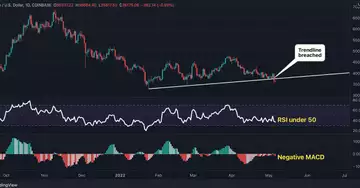Bitcoin's daily chart is trending lower ahead of U.S. jobs data for April and wage growth data, which could influence market expectations on the pace of monetary tightening by the Federal Reserve (Fed).
- On Thursday, the leading cryptocurrency fell nearly 8% to close below an ascending trend line connecting the bullish lows of January 24 and February 24.
- The breakdown of the three-month uptrend line may indicate the resumption of the general decline from the November highs. Popular indicators such as the Relative Strength Index (RSI) and the Moving Average Convergence Divergence (MACD) histogram are also trending lower.
- According to charting platform TradingView, support is at $34,322, the Feb. 24 low, followed by the Jan. 24 low at $32,933.
- The non-farm payrolls report to be released on Friday at 12:30 UTC is expected to show that the economy added 391,000 jobs last month, up from 431,000 in March, according to FXStreet.
- The unemployment rate is expected to have fallen to 3.5% in April from 3.6% in March. Wages likely rose 0.4% and 5.5% year-over-year, the same pace as the previous month.
- With the Fed focused on bringing inflation down, unemployment rate and wage growth numbers will likely overshadow payroll numbers.
- A tight labor market and wage increases lead to inflation, so above-consensus wage growth and a decline in the unemployment rate could heighten inflation concerns and increase the likelihood of a 75 basis point rate hike next month. This could put additional downward pressure on risk assets, including bitcoin.
- The Fed raised rates by 50 basis points on May 4 and indicated that larger hikes are likely in the coming months. The central bank also announced that it would begin reducing its nearly $9 trillion balance sheet.
- While Fed Chairman Jerome Powell said policymakers are not actively considering a 75 basis point hike, that forecast could be based on expectations that the labor market is cooling and inflation is peaking.
- Powell made it clear that the central bank is willing to tolerate an economic recession in order to bring inflation down, which leaves the door even wider open for another rate hike.

